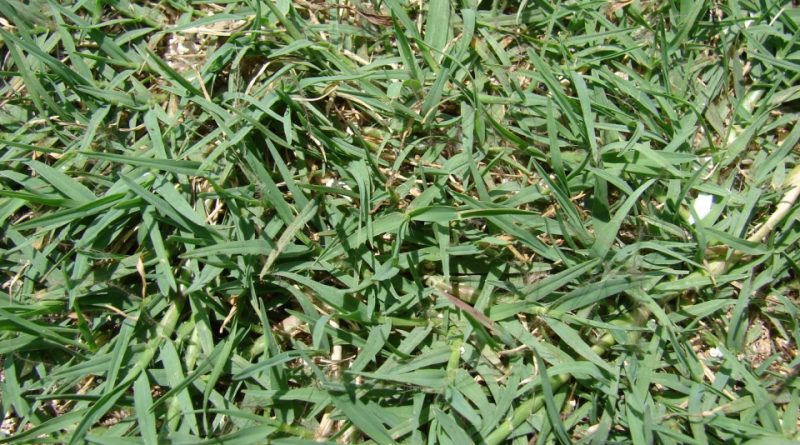Cynodon dactylon
Cynodon dactylon
The Vilfa stellata or Bermuda grass (Cynodon dactylon (L.) Pers., 1805) is a perennial herbaceous species of the Poaceae family.
Systematic –
From a systematic point of view it belongs to the Domain Eukaryota, Kingdom Plantae, Division Magnoliophyta, Class Liliopsida, Order Poales, Family Poaceae, Subfamily Chloridoideae, Tribù Cynodonteae and then to the Genus Cynodon and to the Specie Cynodon dactylon.
Etymology –
The term Cynodon comes from the Greek κύων, κυνός cyon, cynòs dog and from the Greek ionic ὀδών odón tooth: dog’s tooth. The specific epithet dactylon is also of Greek derivation, δακτυλος dáctylos finger: reference to the typed shape of the inflorescence.
Geographic Distribution and Habitat –
Cynodon dactylon is a species most likely native to India, from where it has spread throughout the world. It grows from the sea level up to about 2200 m s.l.m. in soils mostly sandy, dry but rich in nutrients and in Italy it is widespread in Italy in the fields and in the vegetable gardens. It is a species that tolerates salinity on average and is very resistant to cold.
Description –
The Bermuda grass is a weed with nodose, large rhizome (3-4 mm) with 3-6 cm long internodes, large scales, thinner bark of the inner cylinder, prostrate stem, distal leaves, linear and persistent. Spikes are inserted in number from 3 to 7 on the apex of the culm with the typed arrangement.
Cultivation –
Cynodon dactylon is a species that is often grown for grassy meadows where it is more difficult to use other essences such as Poa pratensis, Lolium perenne and other similar species. The plant prefers warm and tropical temperate climates, being its optimal growth temperature of about 35 ° C. it grows well in dry soils, humus-poor but rich in mineral elements, and finding good conditions in sandy or low-consistency soils. It can also be grown in medium-salty soils and its accidental spread, especially as a weed, is favored by nitric fertilization and by working the soil with rotating organs that contribute to incredibly spread the plant, through the rhizomes.
It can be easily planted by vegetative means even on roughly prepared soils; sowing is rarer and, in any case, should be done on a well-refined bed with at least 10 kg of seed per ha.
Uses and Traditions –
Cynodon dactylon is a very competitive species with an extensive root system. It is also used in turfgrass with warm climate, given its high resistance to trampling, and is considered a weed of meadows and fields. Despite being a graminacea, the allergenic properties of its pollens are distinguished from other plants of the family. It has remarkable diuretic properties and is a medicinal and medicinal herb.
The rhizome of the Bermuda grass is harvested throughout the year (better, however, in September-October, or in March-April). For the use it is cleaned from the ground and the side rootlets are eliminated, then dried in the sun or hung in bunches and stored in paper or canvas bags.
The Bermuda grass is very appreciated by pigs. If you want to get rid of this weed, use these animals, which, digging into the ground, root out the rhizomes. Moreover, the quality of fodder is good and of excellent palatability.
The active ingredients of Cynodon dactylon are: fructose, triticin, mannitol, inositol, malic acid, mucilage, saponin, vanilligloside, amygdalin, agropyrene in essential oil, silicic acid, potassium and iron salts, vitamins A, B.
Its main properties are: diuretic, depurative, anti-inflammatory, refreshing, thirst-quenching. It is used as a decoction to purify the body in the spring, it is useful for inflammation of the kidneys and the urinary system in general and to eliminate small stones.
In internal use it is used to increase diuresis, refresh, quench thirst.
But the Bermuda grass also has ancient uses in the kitchen; once it was used as an ingredient to be joined to the flour for bread making, the gramigna was also used in the preparation of beer. The tender leaves can be eaten in salads. The buds, whitish and tender, should be boiled and seasoned with good oil. They are a nutritious and tasty dish, as well as curious and unusual.
Preparation Mode –
The Bermuda grass can be very usefully used in the kitchen; the buds, whitish and tender, can boil and season and are a nutritious dish. Fresh rhizomes are edible. In the past, as mentioned, especially in times of famine, they were used, after drying and grinding, mixed with flour, to make bread. A coffee substitute was also produced, after shredding and roasting.
An excellent decoction can be made from this plant. Just boil two handfuls of rhizome of gramigna in a liter of water for a minute or so, filter and pour the cooking water.
Wash and pound the rhizome well, boil it in another liter of water for 10-15 minutes and sweeten with sugar or honey.
You can also prepare the tincture: 20 g of rhizome in 100 ml of alcohol at 20 degrees (to be rinsed for 10 days). Use: three to four teaspoons a day.
Guido Bissanti
Sources
– Acta Plantarum – Flora of the Italian Regions.
– Wikipedia, the free encyclopedia.
– Treben M., 2000. Health from the Pharmacy of the Lord, Advice and experience with medicinal herbs, Ennsthaler Publisher
– Pignatti S., 1982. Flora d’Italia, Edagricole, Bologna.
– Conti F., Abbate G., Alessandrini A., Blasi C. (edited by), 2005. An annotated checklist of the Italian vascular flora, Palombi Editore.
Warning: Pharmaceutical applications and alimurgical uses are indicated for informational purposes only and do not in any way represent a medical prescription; there is therefore no liability for their use for curative, aesthetic or food purposes.


